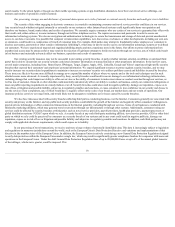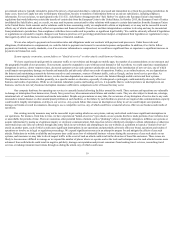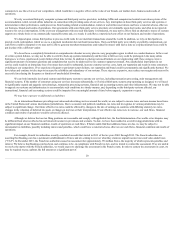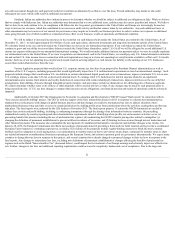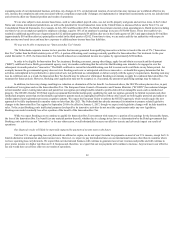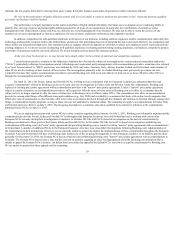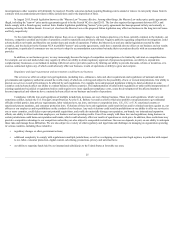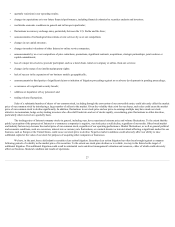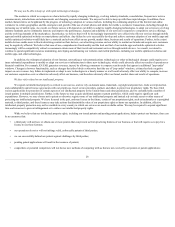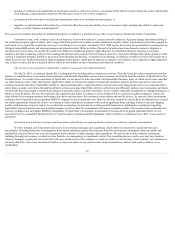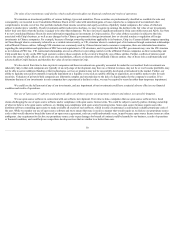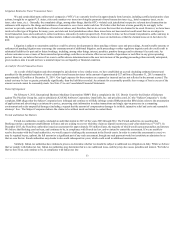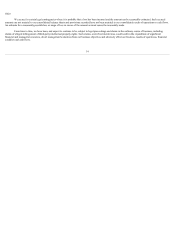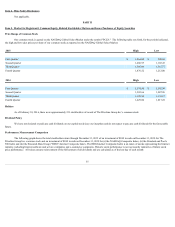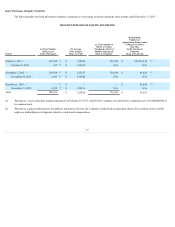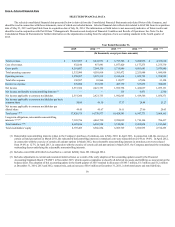Priceline 2015 Annual Report Download - page 31
Download and view the complete annual report
Please find page 31 of the 2015 Priceline annual report below. You can navigate through the pages in the report by either clicking on the pages listed below, or by using the keyword search tool below to find specific information within the annual report.
We may not be able to keep up with rapid technological changes.
The markets in which we compete are characterized by rapidly changing technology, evolving industry standards, consolidation, frequent new service
announcements, introductions and enhancements and changing consumer demands. We may not be able to keep up with these rapid changes. In addition, these
market characteristics are heightened by the progress of technology adoption in various markets, including the continuing adoption of the Internet and online
commerce in certain geographies and the emergence and growth of the use of smart phones and tablets for mobile e-commerce transactions, including through the
increasing use of mobile apps. As a result, our future success will depend on our ability to adapt to rapidly changing technologies, to adapt our services to evolving
industry standards and to continually innovate and improve the performance, features and reliability of our services in response to competitive service offerings
and the evolving demands of the marketplace. In particular, we believe that it will be increasingly important for us to effectively offer our services through mobile
apps and mobile optimized websites on smart phones and tablets. Any failure by us to successfully develop and achieve customer adoption of our mobile apps and
mobile optimized websites would likely have a material and adverse effect on our growth, market share, business and results of operations. Further, to the extent
mobile devices enable users to block advertising content on their devices, our advertising revenue and our ability to market our brands and acquire new customers
may be negatively affected. We believe that ease-of-use, comprehensive functionality and the look and feel of our mobile apps and mobile optimized websites
increasingly will be competitively critical as consumers obtain more of their travel and restaurant services through mobile devices. As a result, we intend to
continue to spend significant resources maintaining, developing and enhancing our websites and mobile platforms, including our mobile optimized websites and
mobile apps, and other technologies.
In addition, the widespread adoption of new Internet, networking or telecommunications technologies or other technological changes could require us to
incur substantial expenditures to modify or adapt our services or infrastructure to those new technologies, which could adversely affect our results of operations or
financial condition. For example, KAYAK generates revenues, in part, by allowing consumers to compare search results that appear in additional "pop-under"
windows. Changes in browser functionality, such as changes that either block or otherwise limit the use of "pop-under" windows, at times has had a negative
impact on our revenues. Any failure to implement or adapt to new technologies in a timely manner or at all could adversely affect our ability to compete, increase
our customer acquisition costs or otherwise adversely affect our business, and therefore adversely affect our brand, market share and results of operations.
We face risks related to our intellectual property.
We regard our intellectual property as critical to our success, and we rely on domain name, trademark, copyright and patent law, trade secret protection
and confidentiality and/or license agreements with our employees, travel service providers, partners and others to protect our proprietary rights. We have filed
various applications for protection of certain aspects of our intellectual property in the United States and other jurisdictions, and we currently hold a number of
issued patents in multiple jurisdictions. Further, in the future we may acquire additional patents or patent portfolios, which could require significant cash
expenditures. However, we may choose not to patent or otherwise register some of our intellectual property and instead rely on trade secret or other means of
protecting our intellectual property. We have licensed in the past, and may license in the future, certain of our proprietary rights, such as trademarks or copyrighted
material, to third parties, and these licensees may take actions that diminish the value of our proprietary rights or harm our reputation. In addition, effective
intellectual property protection may not be available in every country in which our services are made available online. We may be required to expend significant
time and resources to prevent infringement or to enforce our intellectual property rights.
While we believe that our intellectual property rights, including our issued patents and pending patent applications, help to protect our business, there can
be no assurance that:
• a third party will not have or obtain one or more patents that can prevent us from practicing features of our business or that will require us to pay for a
license to use those features;
• our operations do not or will not infringe valid, enforceable patents of third parties;
• we can successfully defend our patents against challenges by third parties;
• pending patent applications will result in the issuance of patents;
• competitors or potential competitors will not devise new methods of competing with us that are not covered by our patents or patent applications;
28


